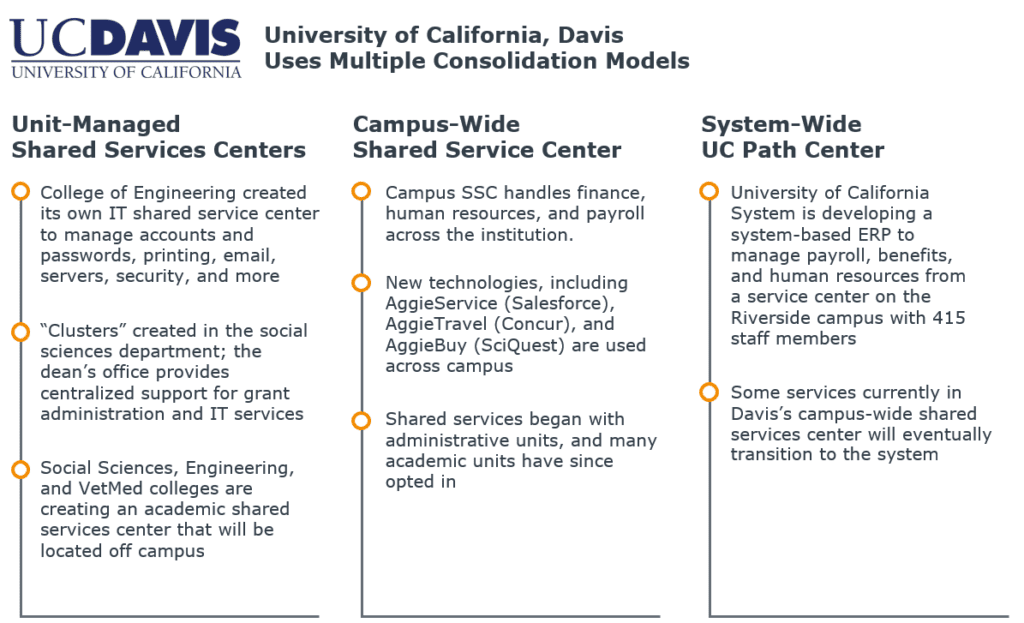Shared services organizations absorb administrative work from distributed campus units to realize efficiency and quality improvements.
Based on extensive research and review of shared services in higher ed, EAB has identified three common organizational models. The models strike a balance between two factors: The efficiency of process standardization and responsiveness to units’ service expectations.
While the number of services to be provided and the size of the customer base will influence a campus’s decision about which organizational model to select, the efficiency/customer responsiveness balance is the most important to get right.
This resource is part of the Design a Shared Services Model That Reflects Campus Priorities Roadmap. Access the Roadmap for stepwise guidance with additional tools and research.
Related resource
How 24 Shared Services Centers Deploy Staff and Technology to Scale Administrative Support
Download the CompendiumThe chart below illustrates the three common shared services models:
- A single, centrally managed center that performs selected functions for client units;
- Multiple, centrally managed hubs, each focusing on a specific set of client units;
- Localized shared services centers managed at the college or unit level, serving departments in that unit.
Three Major Shared Services Models for Balancing Efficiency and Customer Responsiveness
| Model | Example | Strengths |
| Single, centrally-managed center | A single shared services center at the University of Michigan handles an average of 65,500 cases per month across seven major service areas | A single unit offers the greatest scale and opportunity for process standardization and service |
| Multiple, centrally-managed hubs | At the University of Kansas, four shared services centers provide a standard set of services to customers grouped by location and type (admin, humanities, sciences, etc.) | Geographic proximity and segmented focus can alleviate perceived fears about service quality |
| Unit-managed center | At the University of Washington, multiple units have created their own shared services centers that provide unit-specific tasks based on local needs | More customized service for units with specialized needs; also useful when buy-in varies across pockets of campus |
The three shared services models
This model offers the greatest opportunity for efficiency through standardizing administrative processes across the university and consolidating staff into a single center. Equipped with the right technology and reporting tools, a centrally managed center can more easily track its performance, which helps inform service-level agreements with customers and activity-based chargeback mechanisms. A single, co-located center also offers shared services staff opportunities for more professional development than in their former units. Rather than maintaining competencies in many different areas, as is often the case in decentralized departments, staff can focus on developing expertise in a specific functional terrain.
This model is a compromise between centralization and decentralization. Here, staff are consolidated into administrative clusters serving closely aligned colleges or administrative units. Shared services hubs have multiple benefits: they are especially attractive to large, highly decentralized institutions, where one central entity may struggle to understand and respond to the needs of many autonomous departments, centers, and units. Institutions lacking space for a co-located center are likely candidates for the hubs models. Faculty may also not fret the loss of service quality as acutely, given the perceived proximity of “their” staff.
However, shared services hubs do not always achieve the same economies of scale as the single, consolidated center. Leaders must also ensure that each hub maintains uniform business practices, which can be difficult to supervise. Campuses also report greater difficulty in capturing financial savings over time if shared services staff are not managed as part of a single organization.
In this model, individual colleges or units create their own locally managed shared services centers. Staff within these units will specialize either by client unit (e.g., department) or by function (e.g., procurement). The benefits of this model include the ability to offer a high degree of customization to the needs of the unit. This approach can be an effective onramp for campus-wide shared services initiatives, as it helps faculty become more comfortable with the idea of sharing staff across departments. On the other hand, unit-managed centers offer far fewer economies of scale than the other models. Unit-level backfilling can undermine the potential efficiency gains that make attrition savings possible.
Managing a portfolio of shared services organizations
Notably, some campuses have cultivated a portfolio of the above shared services models. As an example, consider the University of California, Davis. There, one college created its own unit-managed center for IT needs, and another established a unit-managed center for grant administration support. Meanwhile, the institution has a campus-wide shared services center that handles finance, human resources, and payroll tasks for all units. This multimodal approach, with different services consolidated at different levels, works well for a large institution like UC Davis. Campus leaders can pinpoint the right balance of scale and service for every administrative activity.
Multimodal Approach to Shared Services at the University of California, Davis
Learn how other campuses have designed their shared services organizations
For campus leaders interested in learning how other campuses have designed their shared services organizations, EAB has compiled profiles of 24 shared services units across 19 institutions into a single compendium.



